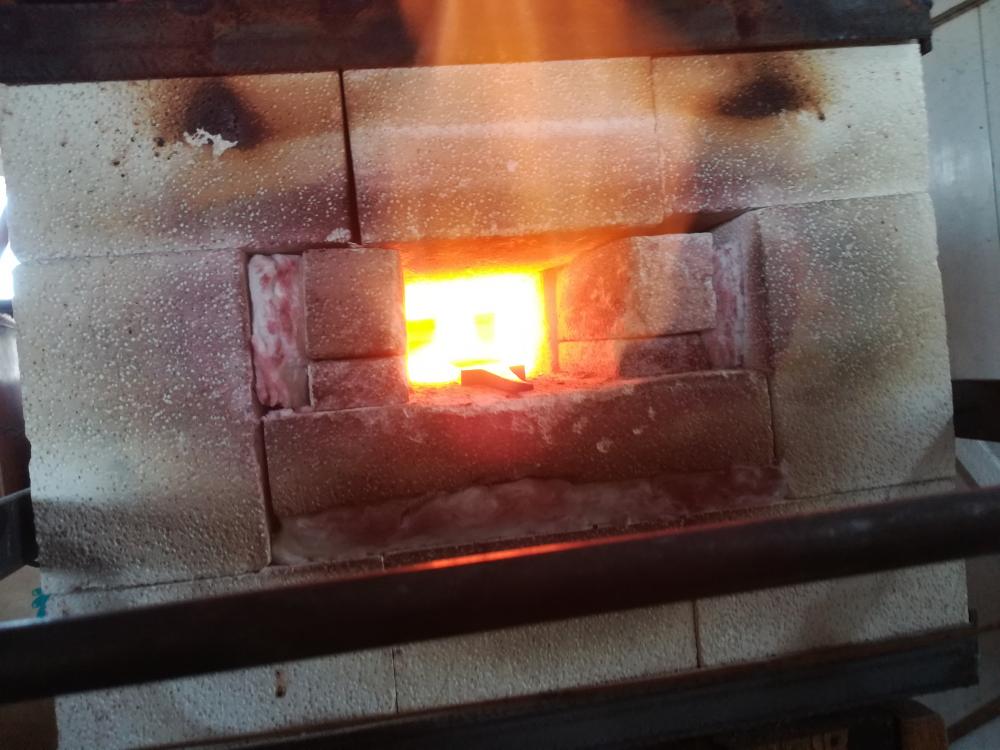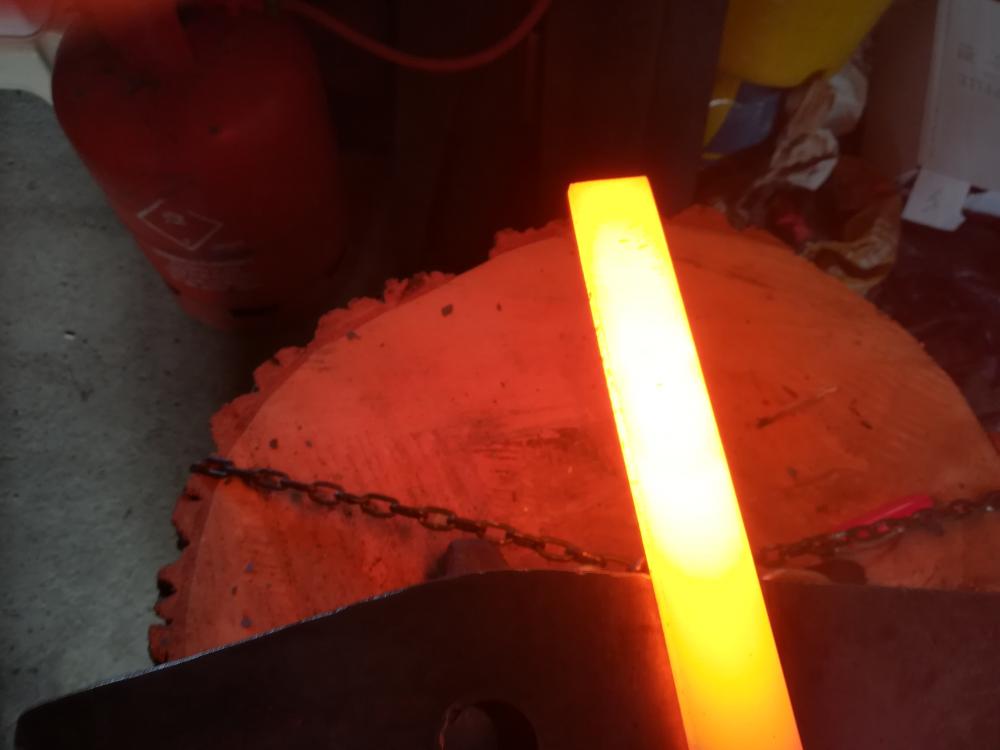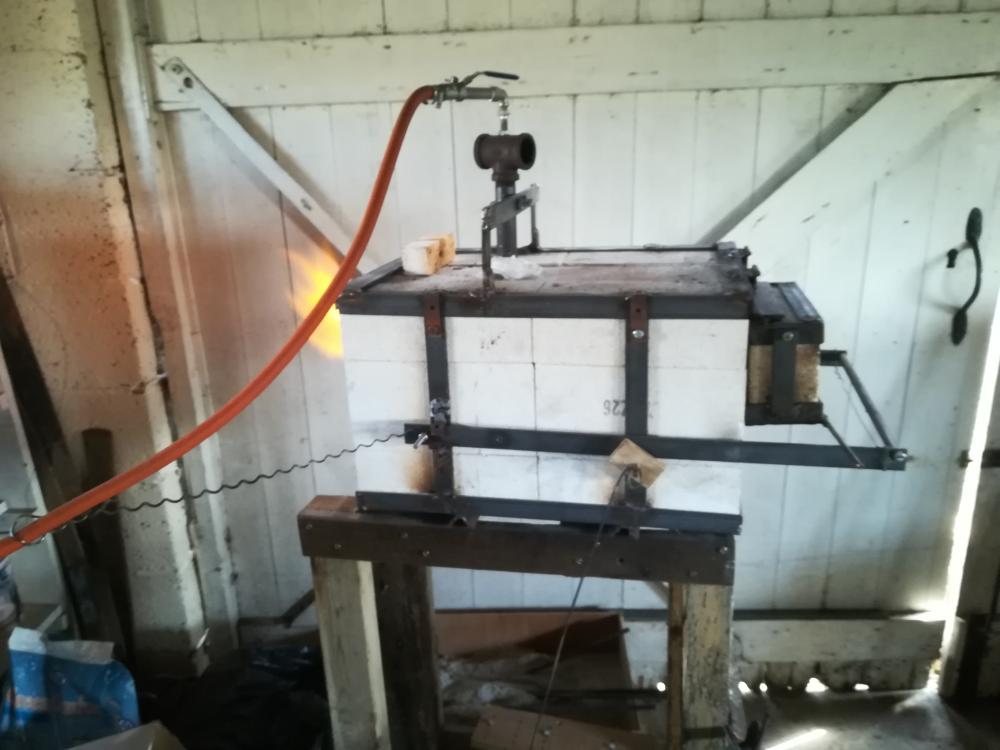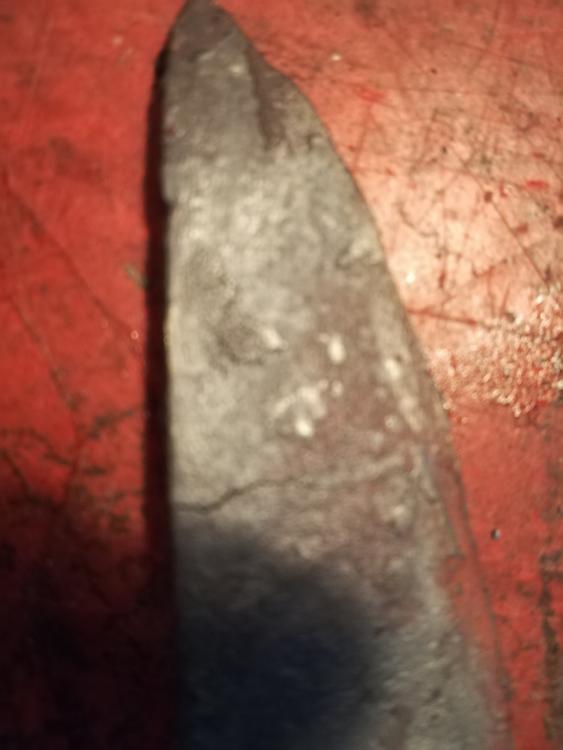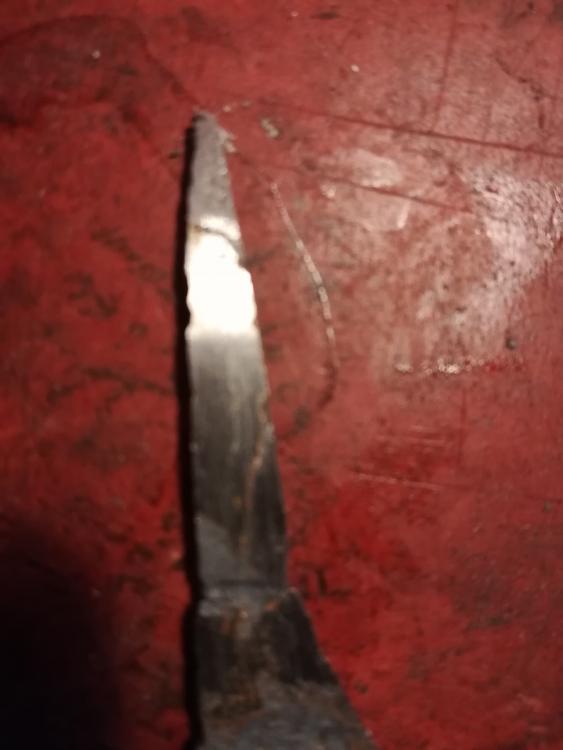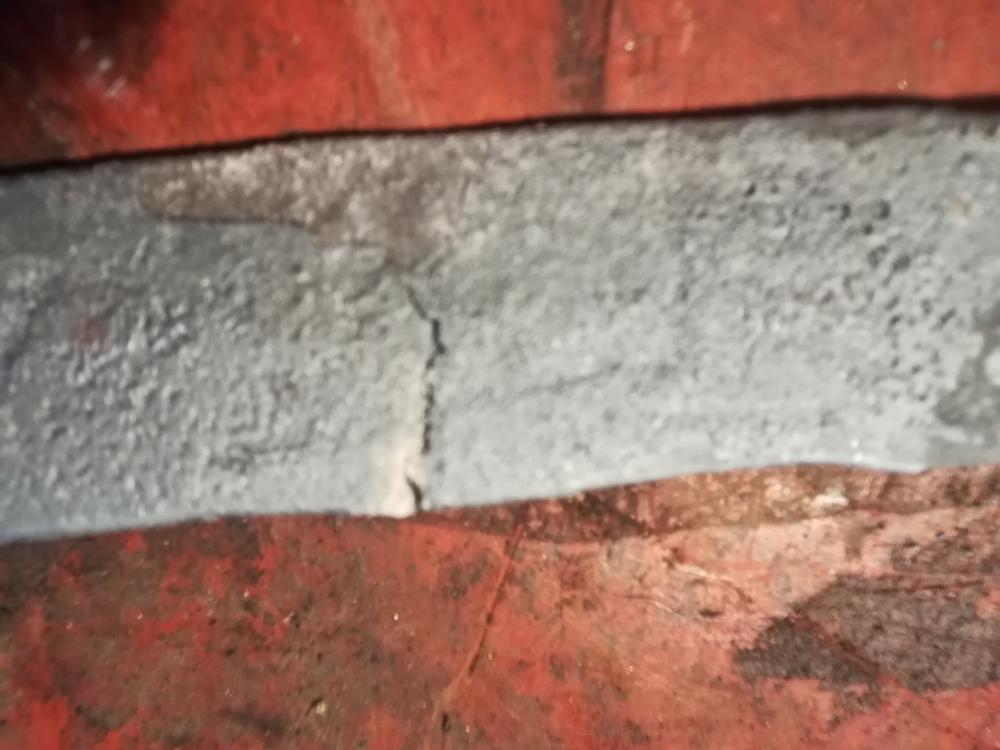-
Posts
23 -
Joined
-
Last visited
Content Type
Profiles
Forums
Articles
Gallery
Downloads
Events
Everything posted by Vandle
-
Would love to use a power press or hammer, but I have no room and limited budget. This is a hobby rather than a business, and regulations won't let me build any additional buildings as I live in a listed 17th century thatched cottage - not allowed to do any changes to the building or anything in the property boundaries.
-
Many thanks Frosty - I kept the door shut for the camera. I'll give the 101 thread a good study. John
-
Many thanks Thomas. I'll try the cat litter. The camera does show the metal as slightly yellower than it is, and we all see things differently anyway, so the reason I've been starting at this temperature I guess is that I see so much general smithing done at this sort of temperature. I have tried hammering a leaf spring and get absolutely nowhere unless I get the temperature as high as I can. Big muscles I never had - so that's a bit of a disadvantage. Sounds like a few of us are getting head related problems for one reason or another - and there's me worrying that blacksmiths end up getting burned. None so far!
-
After 5 - 10 minutes with an old oily file. Temperature that I start to work at. When the tip dulls to black and the centre is still cherry red I return it. Sometimes I'll lightly work it black to smooth out any large deformities. Normally, after 30 minutes with the front door down, the exhaust is blue. One final question, i tried welding metal unsuccessfully and found that the Borax turns the ceramic brick into toffee. The manufacture recommended a Zirconium paint, but they only sold it in quantities large enough to do 50 of these forges at least - and at $70 a time. Any other way of protecting the lining from Borax?
-
Forge set up with door closed. 6 ceramic kiln bricks top and bottom, two each side, inner lining of ceramic wool and cut down ceramic bricks as inner replaceable liners. Garage doors kept shut to keep things darker. Front entrance when just lit. VID_20180414_105139.mp4
-
Yes - I tried holding wok off the anvil and when it works it's a great satisfaction bouncing the work, but a technique that will take a while to learn consistently. I'll give the hot anvil a go.
-
Started with rebar and made a few tongs until I was fairly comfortable with some very basic techniques. Made a few church candle holders no problem ( I keep bees so plenty of wax). Forge is squeezed in to my garage entrance, so very wide doors right where the forge is. I had a TIA 6 weeks ago (unrelated to blacksmithing) and spent a night in hospital, so very conscious of lack of oxygen to the brain. I've been practicing thinning and extending metal, but my German anvil has sharp edges so have been using the horn to extend metal. It seems working mild steel is straightforward - moving to another steel caused the problem. Maybe I should stick to blacksmithing for a little longer. I'll try heating the anvil - It hasn't been much above 8 degrees so far this year (centigrade). Doesn't that need a massive heat capacity? I need to make some hardy tools anyway.
-
I guess I'm a typical amateur - threw it all together and hoped for the best. Many thanks guys for all of this. I'll spend some serious time on this to get to grips with it. John
-
OK. I have no idea as to how I have the forge set up regarding CO. Doors are always open and I have a CO detector close by. Now you are talking to a real new boy here, despite his 64 years, so a lot to learn. Point me in the direction where I can understand what a reducing atmosphere, and what I need to do to control it is please. I do leave it in the forge for quite a while as the metal cools so quickly. From video's I've watched, blacksmiths seem to be working metal for longer than I do. Less than a minute each time. I'll check grain size tomorrow.
-
OK , will do tomorrow. If you're THE Frosty, then it's one of your T-burners! It's a 1" 3/4" 1" T with no control over air inlet.
-
Sometimes I'm hammering lightly to take out any bending in the steel before returning to heat, but I thought you could tidy up metal when dark? I do have the steel directly under the flare, should it be to one side in the gas forge?
-
Really? I've tried forge welding and can't get it hot enough - thought I'd need a second burner. It's usually very bright red. I'll try lower temperatures. Thanks.
-
I've made a few nice blades from O1 steel, but this week thought I'd make some from recycled metal. First off an old file that went well until I noticed a crack in the tang. I heated it again and the tang just fell off. After I cooled the blade and cleaned it up, realised (sorry - UK spelling) a massive crack across the tip was also a problem. Started afresh with a length of coil spring and the same thing happened - small cracks appearing as the blade edge was being formed. Tried a third time to make a letter opener from a small file, and the same thing again. So, I understand the coil spring could have deformities in it already, but three on the trot makes me thing I'm forging incorrectly. Any thoughts?
-
Well I guess they thought the minerals in urine did something to the steel maybe. My mother was trained by her father back in the late 1940's, who in turn had been trained as a stonemason just after the First World War - I guess people were still doing things as they had done for centuries. This was in central Europe and no doubt before the advent of cheaply available oil, so people generally would have quenched in water. Sounds disgusting now, but 100 years ago sanitation was almost non existent in their small village, so collecting urine to quench chisels was probably thought quite normal. Just wondered if anyone else had come across this, whether there was merit in it or just another ancient activity like blood letting and leeches that have no scientific basis. I'm not planning on following the family tradition by the way! Vegetable oil seems a bit easier. Had to edit this as the moderator warned me about the use of the word da*n - a cultural difference I think since it is just a commonly used word in the UK with no offence inferred. Apologies to anyone who was offended. Anyway, end of subject.
-
Many thanks for all the advice guys. I got the forge working in the end - in the forge the burner lit fine even outside it would not light. I increased the size of the flare so that now it is all working fine as a burner on its own and within the forge. Just hardened my first knife blade so very happy!.. The forge body itself is so far running ok, but when I first lit it I ended up with a face full of particles from the lining blanket, so lined the inside with fire cement. This is slowly coming apart and the fire blanket seems to be degrading. I used a couple of fire bricks out of the lining of a log burner as a floor and they too are rapidly dissolving. Overall I'd say the chimney liner idea is ok as a first attempt with parts that cost me next to nothing, but wouldn't recommend it as a long term forge. I'll get some bricks from Vitcas next and build a small brick forge. Thanks again.
-
Well I guess they thought the minerals in urine did something to the steel maybe. My mother was trained by her father back in the late 1940's, who in turn had been trained as a stonemason just after the First World War - I guess people were still doing things as they had done for centuries. This was in central Europe and no doubt before the advent of cheaply available oil, so people generally would have quenched in water. Sounds disgusting now, but 100 years ago sanitation was almost non existent in their small village, so collecting urine to quench chisels was probably thought quite normal. Just wondered if anyone else had come across this, whether there was merit in it or just another ancient activity like blood letting and leeches that have no scientific basis. I'm not planning on following the family tradition by the way! Vegetable oil seems a xxxx site easier.
-
My mother was a stonemason back in the 40's and they made all their own tools. The men peed in a bucket and tools were quenched in neat urine. I know this is unrelated to the original topic, but anyone had any experience of this?
-
Just chilling to Rag n Bone man over a bottle of French red, so back to forging in the morning. Will let you know.
-
I have a double walled chimney liner with internal insulation. I'll add two layers of insulation wool and an insulated brick floor inside it. The steel wall of the liner is very thin, hence it may not be sufficient to withstand the heat. Depends on the insulation. It's free, so I thought I'd try it as an experiment. You never learn without busting a few things!
-
Not assembled the forge yet Jasent. Thanks for that, will start on it tomorrow. I'm trying something a bit different for the forge — it will either work brilliantly or melt!!! Will let you know.
-
Thanks to all of your great replies. I received a 1/8" BSP steel hydraulic fitting today as suggested by TimGunn (cheers Tim), drilled and tapped to M6 successfully and built the T-burner. Unfortunately, no Jasent, I have not used a 1" T. It's 3/4" pipe fittings all the way round. The burner either wont light unless I turn the gas almost off, or it lights at the mig tip and burns down the length of the tube. Too much air, too little air? I'm running at about 7 - 14 psi (0.5 to 1 bar). Any ideas anyone. Not fitted a flare as yet since I had hoped I would get something out of the burner to heat the pipe I'm planning to flare out. I've adjusted the position of the MIG tip from way back in the T to almost inside the burner pipe with no effect. I've even cut down a MIG tip to ensure it's not too extended. My only variation from the plan is that I have used this http://pipeworksuppliers.co.uk/index.php?route=product/product&path=80&product_id=208 Should have read the instructions a little more, but I've since seen posts where people have had to reduce the air intake of Frosty's burner. I'll wait a while before ordering a 1" by 3/4" T just in case anyone has another idea. This is the second burner I have built, the original last week a Ron Reil burner did exactly the same as this which I put down to poor build on my behalf. I then came across this T burner and thought it would be easier. Pressure related? Seems odd that both have a similar problem.
-
Just trying to build a Frosty T-burner in the UK. I have a 3/4 inch T and a 6" * 3/4" pipe. Gas pipes are 1/8" BSP Tapered pipe and I have bought a 1/8" male to male nipple to fit in the T. Problem is our MIG tips have an M6 metric fitting, which is a sloppy fit inside a 1/8" BSP pipe nipple. I've looked everywhere online to find an alternative way of fitting the MIG tip but no luck so far, so maybe someone on the forum has had a similar problem and come up with a solution?? I should live in the States maybe?


